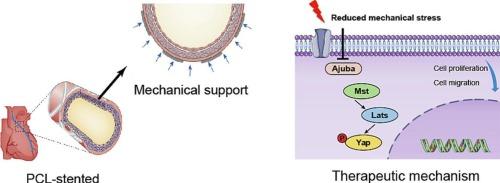体外支架通过阿朱巴介导的Hippo信号通路抑制改善静脉移植物重塑
IF 6
2区 医学
Q2 MATERIALS SCIENCE, BIOMATERIALS
Materials Science & Engineering C-Materials for Biological Applications
Pub Date : 2025-07-21
DOI:10.1016/j.bioadv.2025.214427
引用次数: 0
摘要
隐静脉移植物(SVGs),通常用于冠状动脉搭桥手术,容易失败,由于内膜增生。尽管体外支架已被用于减少机械应力和改善静脉移植物重塑,但与机械应力相关的生物学机制仍不完整。在本研究中,我们确定了limm结构域蛋白Ajuba的生物学意义,并确定了其在SVGs中Hippo信号通路的应激调节机制。体外支架在体内应用可降低机械应力,下调Ajuba,维持Hippo信号通路。此外,我们建立了一个体外模型来研究机械应力如何影响Ajuba表达及其对Hippo信号通路的调节,刺激细胞增殖、侵袭和细胞周期进展。总的来说,我们的研究揭示了外部支架背后的机制,并强调了Ajuba作为预防SVG失败的有希望的治疗靶点。本文章由计算机程序翻译,如有差异,请以英文原文为准。

External stent ameliorates vein graft remodeling through Ajuba-mediated suppression of Hippo signaling pathway
Saphenous vein grafts (SVGs), commonly used in coronary artery bypass graft procedures, are prone to failure due to intimal hyperplasia. Although the external stents have been applied to reduce mechanical stress and ameliorated vein graft remodeling, the biological mechanisms linked to mechanical stress remains incomplete. In this study, we identify biological significance of Ajuba, a LIM-domain protein, and defined its mechanism for stress-regulation of Hippo signaling pathway in SVGs. The in vivo application of external stents decreases the mechanical stress, downregulates Ajuba and maintains Hippo signaling pathway. Additionally, we developed an in vitro model to examine how mechanical stress influences Ajuba expression and its impact on the regulation of the Hippo signaling pathway, stimulating cell proliferation, invasion and cell cycle progression. Overall, our research unveils the mechanisms behind external stents and highlights Ajuba as a promising therapeutic target for preventing SVG failure.
求助全文
通过发布文献求助,成功后即可免费获取论文全文。
去求助
来源期刊
CiteScore
17.80
自引率
0.00%
发文量
501
审稿时长
27 days
期刊介绍:
Biomaterials Advances, previously known as Materials Science and Engineering: C-Materials for Biological Applications (P-ISSN: 0928-4931, E-ISSN: 1873-0191). Includes topics at the interface of the biomedical sciences and materials engineering. These topics include:
• Bioinspired and biomimetic materials for medical applications
• Materials of biological origin for medical applications
• Materials for "active" medical applications
• Self-assembling and self-healing materials for medical applications
• "Smart" (i.e., stimulus-response) materials for medical applications
• Ceramic, metallic, polymeric, and composite materials for medical applications
• Materials for in vivo sensing
• Materials for in vivo imaging
• Materials for delivery of pharmacologic agents and vaccines
• Novel approaches for characterizing and modeling materials for medical applications
Manuscripts on biological topics without a materials science component, or manuscripts on materials science without biological applications, will not be considered for publication in Materials Science and Engineering C. New submissions are first assessed for language, scope and originality (plagiarism check) and can be desk rejected before review if they need English language improvements, are out of scope or present excessive duplication with published sources.
Biomaterials Advances sits within Elsevier''s biomaterials science portfolio alongside Biomaterials, Materials Today Bio and Biomaterials and Biosystems. As part of the broader Materials Today family, Biomaterials Advances offers authors rigorous peer review, rapid decisions, and high visibility. We look forward to receiving your submissions!

 求助内容:
求助内容: 应助结果提醒方式:
应助结果提醒方式:


